Our elearning software development company has taken top Learning Experience Platforms based on customer reviews, determined and compared their core features, and listed them all, starting from the most expensive one, to make it easier for you to compare. In this overview, you'll also see that in the long term, for companies with a large number of employees, it's more cost-effective to develop a custom LXP, as subscription fees will obviously exceed the cost of development at some point.
A few years ago, the LXP market was estimated to be about $300 million and has been increasing by over 50% annually. By 2026, the LXP market is expected to reach almost $2.2 billion. Thanks to big data analysis, artificial intelligence and an adjustable interface, LXP adapts to each customer’s preferences and needs. LXP could be compared with Netflix in e-learning because of its user-oriented approach and intelligent content recommendation.
Dmitry Baraishuk Belitsoft’s CTO on Forbes.com

How Custom LXP Resolves Typical Learning Challenges
The Forbes expert with 17+ years in eLearning, Belitsoft’s CTO, shows how the LXP helps businesses discover skills gaps across the company, address them by providing properly recommended content, analyze learning outcomes, and improve learning efficiency.
Challenge 1. What to teach?
The primary goal of continuous learning is addressing skills gaps by upskilling employees.
However, business and HR leaders often lack full visibility of what set of skills the employees master and don't measure what skill levels they have. Without this data, they aren't able to timely reveal skills gaps and make data-backed decisions about what to teach for addressing them.
LXP-based Solution: Reveal skills gaps to decide what to teach
We've created a skills management software framework that offers high customization and swift implementation, ensuring you get the best fit for your needs.
Teaching should start from discovering skills gaps, which is the difference between current skills and target skills.
For that, the company creates a skills matrix where they describe which abilities and knowledge should correlate with every skill level.
Having the skills matrix, the company can set up target levels for each position to benchmark the expected competencies for their teams.

To discover a skill gap, the current skills of each employee have to be assessed. It can be realized in different ways:
- by AI-powered assessment tool that is getting popular in Talent Management;
- there is a certified examination made up by the company or a content provider;
- otherwise, employees themselves or their mentors do the self-assessment.
For example, a Data Scientist with the current level 3 in Big Data Analysis can open the position of Data Scientist and see the Target Level and the series of skills that are obligatory for the position.
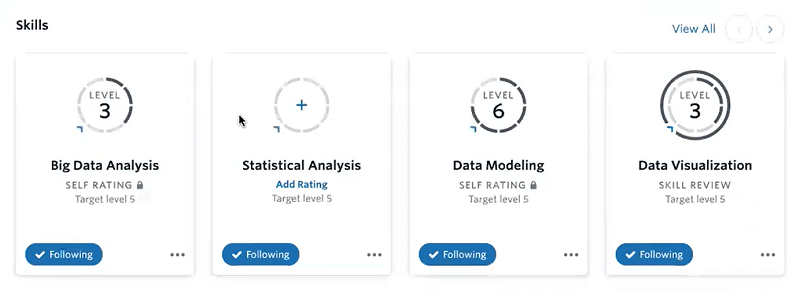
Thanks to the skills matrix, the skills gaps can be measured and analyzed not only on an individual level, but also on a company level. All the information about current skills of employees across the company is gathered in a single analytical dashboard. Thus, managers or educators can see which skills gaps the company faces.
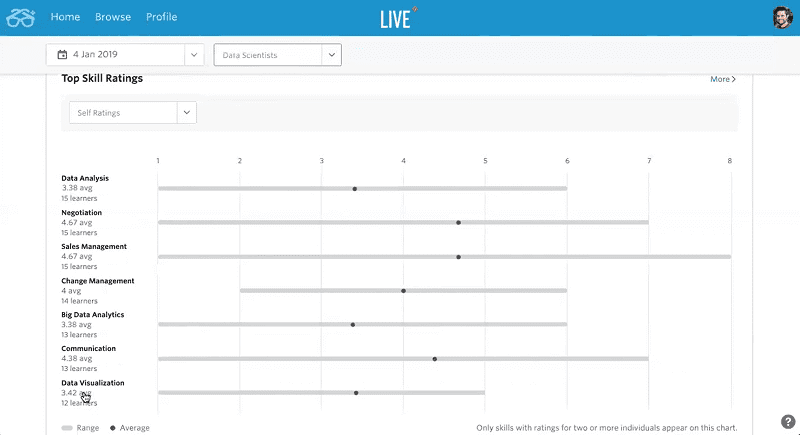
The goal of learning through the LXP is to close this gap by upskilling employees.
Challenge 2. How to teach?
Traditionally, L&D managers or educators offer one-size-fits-all content with a strict, predefined learning path for all employees. Such an approach may not take into account learner's interests, current skills level, and individual learning goals.
Besides, the businesses have to manually update their learning library, spending extra resources on it regularly. Otherwise, the content quickly gets out-of-date and dull, leading to low engagement and poor learning outcomes.
LXP-based Solution: Create a learning path with individually recommended content
To properly address the revealed skills gaps, it's time to create a learning path with the properly recommended content.
Once an employee enters their own profile page, they can see a learning plan assigned to them by the company to develop the target skillset.
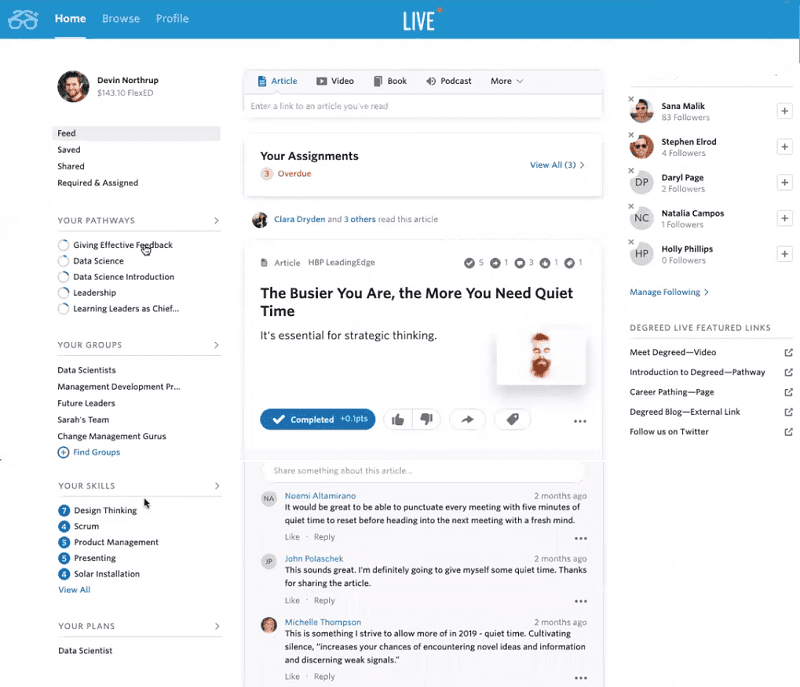
Instead of passing the entire learning process from a zero level, the LXP suggests the employee finding the appropriate content based on their current skill level.
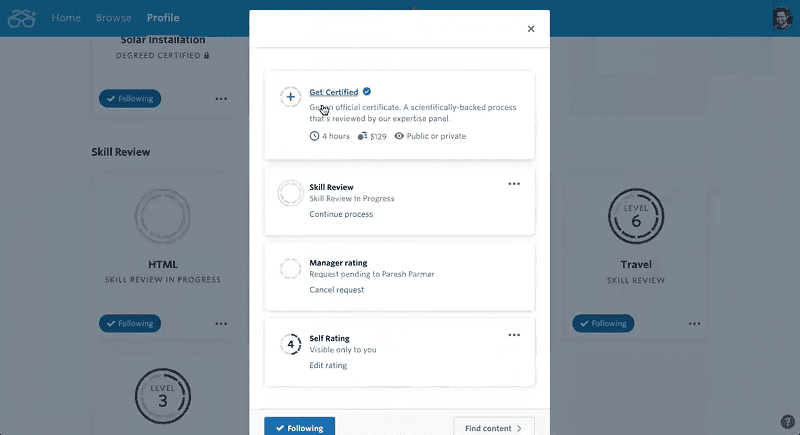
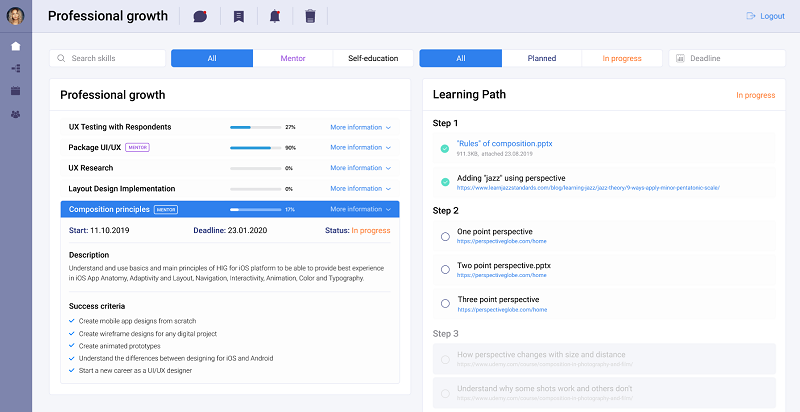
After completing a learning path for mastering a certain skill, an employee returns to the skill assessment. Depending on an LXP, there might be different assessment methods. The most popular and demanded one is a test or exam with certification as a reward.
Challenge 3. How to measure results?
To track the learning process and outcomes, HR and L&D managers or educators regularly create tests or arrange interviews. The process is based on manual work, which consumes a lot of time and implies the risk of biased assessment.
On top of that, without real-time automated analytics, business leaders don't see how many employees are learning, how fast skill gaps are reducing, who are the top performers in their company, and many other useful metrics. As a result, top managers cannot make timely and data-backed decisions about further learning activities.
LXP-based Solution: Automate the tracking of learning progress and outcomes to make data-backed decisions
By tracking the learning progress and outcomes, L&D managers and educators can use it to identify top and low-performing learners objectively. Having such data can be used to see who has best mastered new competencies and can be promoted, and who needs assistance or follow-up.
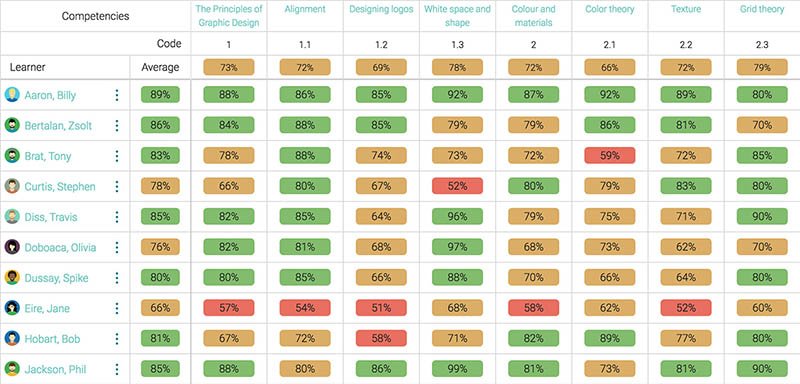
Company managers and educators can also analyze if a skill gap is getting less across the company by getting skill rating analytics.
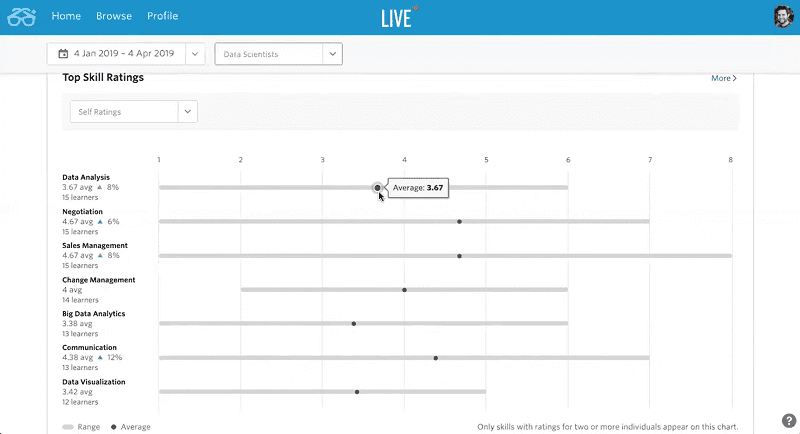
In addition, the company management can get insights about the learning process from multiple other aspects. For example, how many employees are active learners, how many courses are used for learning, which content is most popular, and many other useful metrics.
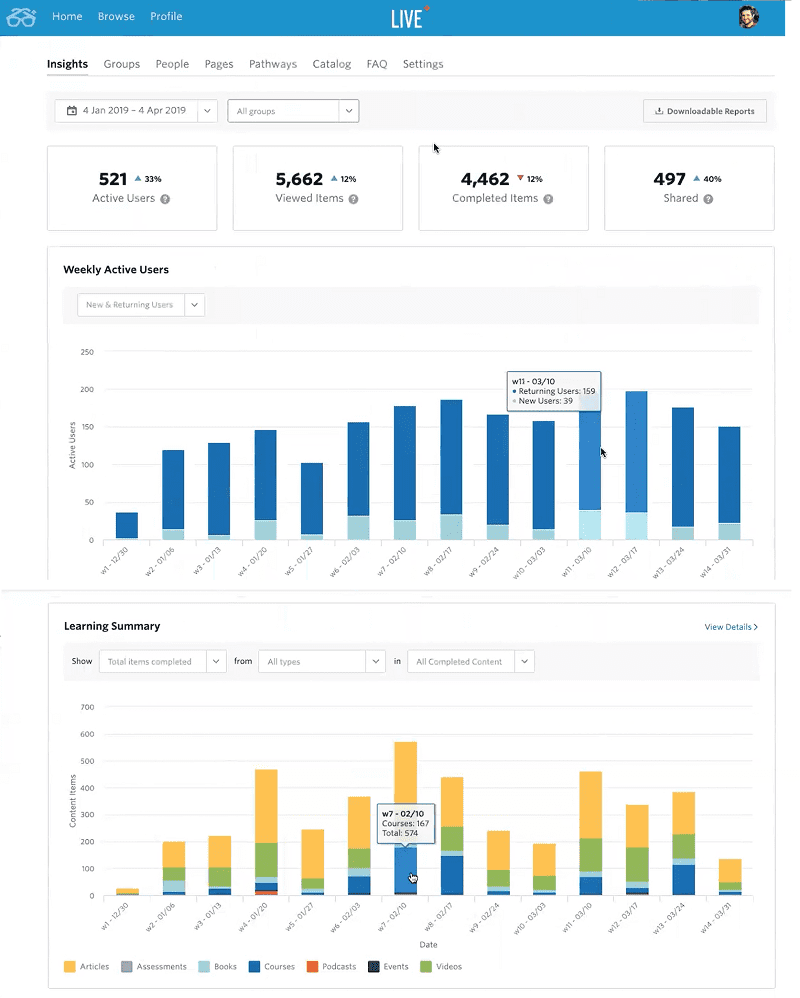
Challenge 4. How to improve results?
Most learning programs are considered successfully completed after finishing the course, without further analysis of whether the learning process has been useful and engaging, and whether employees feel satisfied with the experience. As a result, employees don't feel motivated to start training new skills, the skill gap across the company grows, and investment in training doesn't bring expected outcomes to business.
LXP-based Solution: Keep high learners' engagement to accelerate the adoption of new knowledge
What would you do in case the learning performance tracking shows poor results, or you want to improve the learning outcomes even more? Think, how engaging is the learning content that your company offers?
Learners' engagement is critical for the success of learning. That's why LXPs include not only courses assigned by the company, but also learning based on employee's personal interests. That's one of the differences between LXP and LMS.
The LXP can both import the internal learning content from the company's LMS and integrate external content providers, such as YouTube, TED videos, Google podcasts, and others via xAPI. (xAPI retrieves records from external sources and aggregates them in a learning record store – LRS. xAPI is compliant and widely used by the top LMSs, such as Moodle, Blackboard, Docebo, Learndash, etc.).
Mixing internal and external content makes an LXP a perfect solution to the issue of the up-to-date content shortage that is typical of an LMS.
Microsoft General Manager of Enterprise Corporate Learning, Alessandro Giacobbe, confirms the profitability of integrating LMS and LXP, stating that there is no point in replacing LMS as it’s critical for compliance and professional development; instead, their aim is to provide employees with the broad learning catalog by uniting LXP and LMS. To illustrate, it can be a Sharepoint-based LMS and Microsoft Viva, which also seamlessly interact with Microsoft 365 and Teams, turning into a holistic learning solution.
Anyway, whether you use a standalone LXP or its combination with LMS, here are a couple of features that increase employees' engagement when applied in the LXP.
AI-based content recommendations
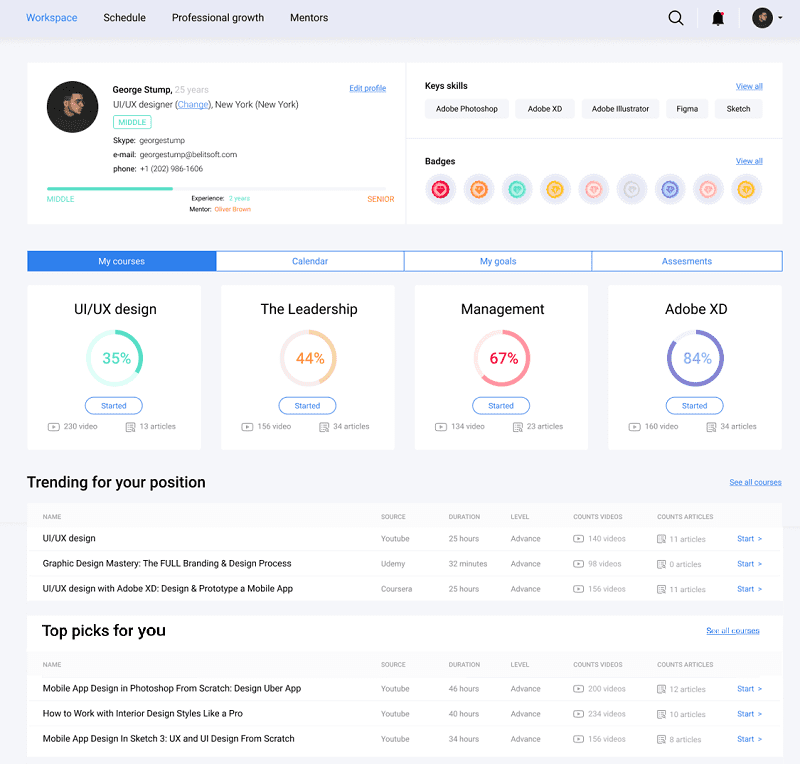
Content recommendations based on learner's personal choice
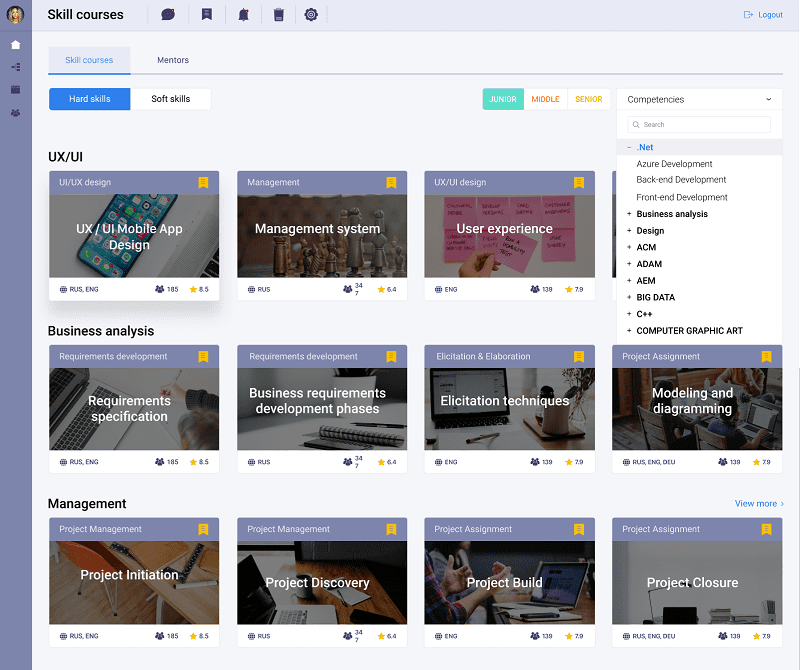
Interactive Chat-based Learning
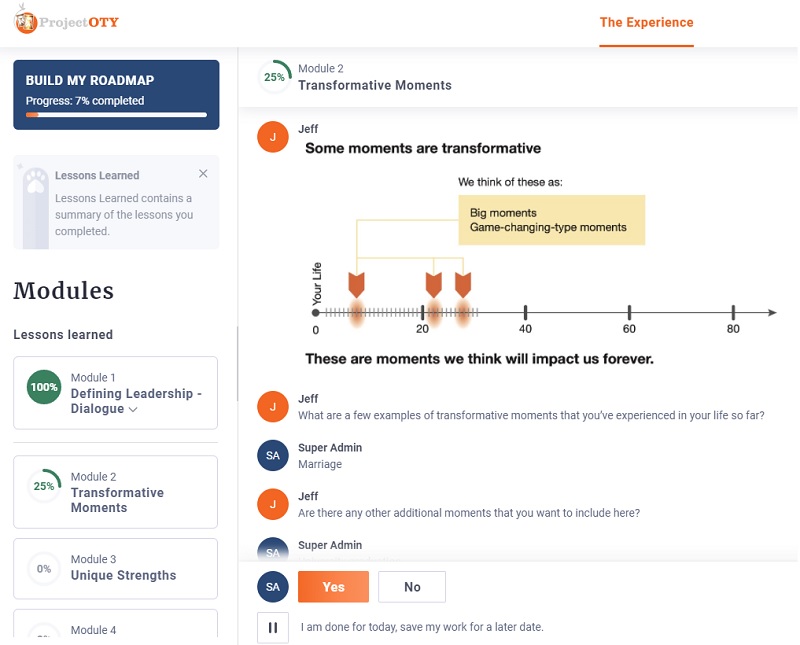
Social learning
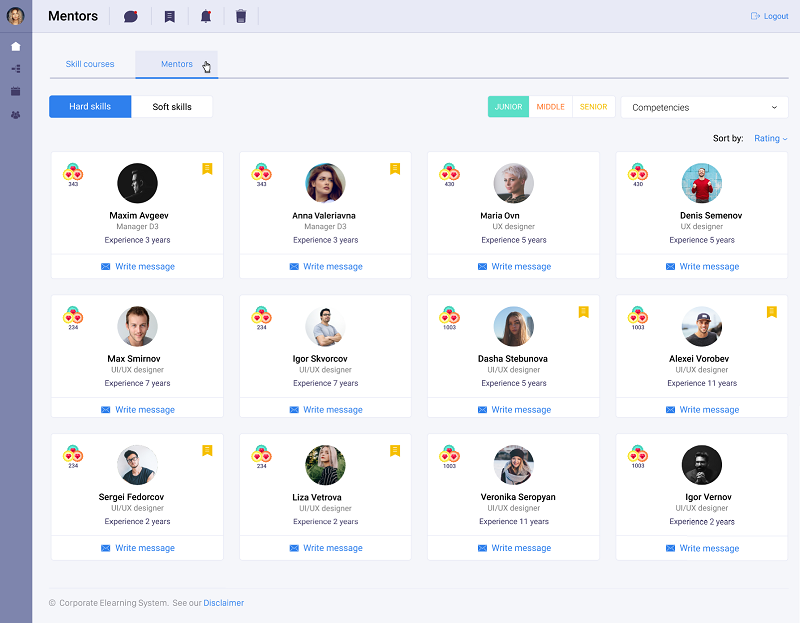
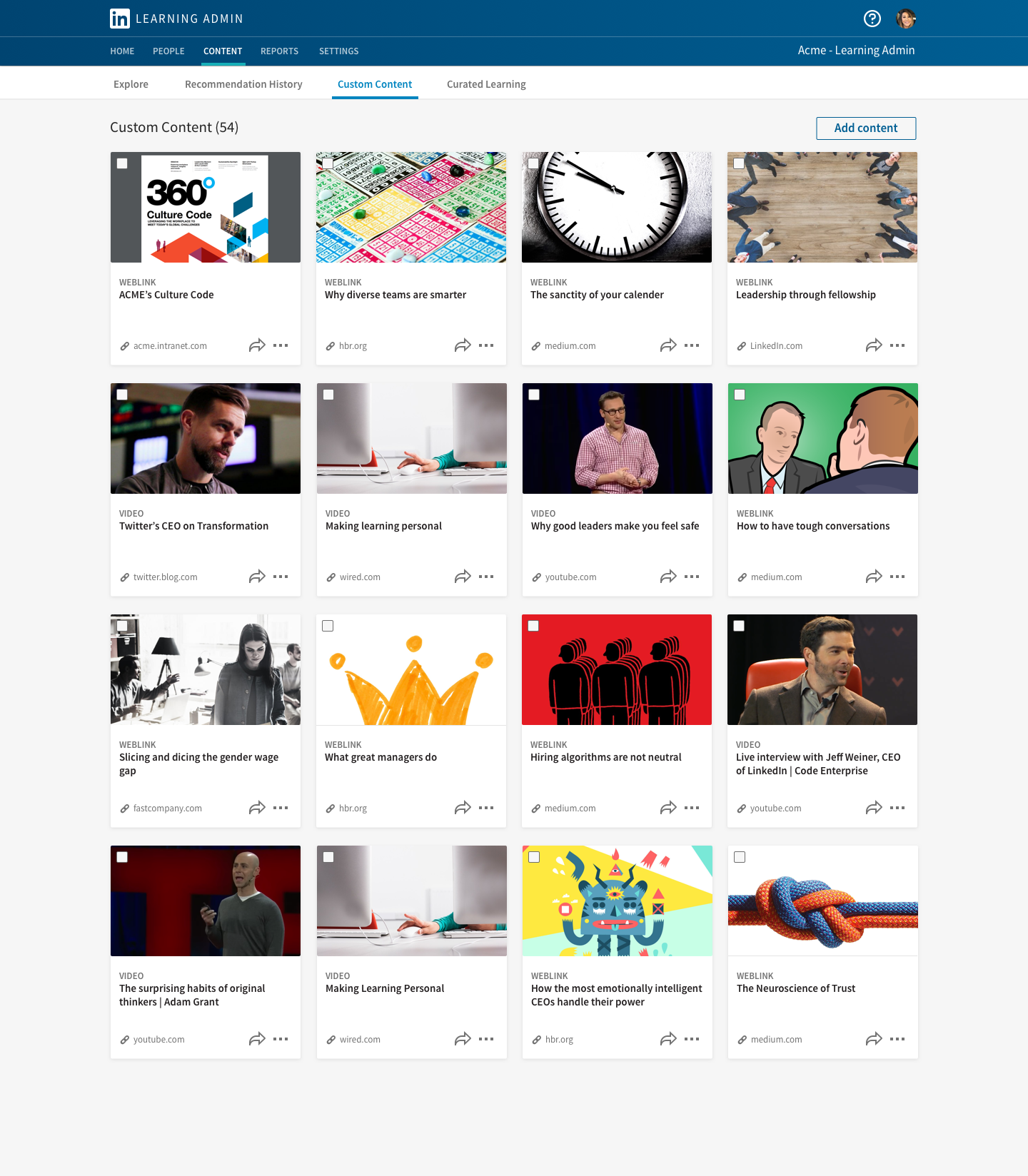
Set of Criteria for Identifying Top LXPs
We've chosen a single set of criteria to be objective and concise in choosing top Learning Experience Platforms on the market:
- LXPs' rating on the most trusted customer reviews platforms—g2.com, capterra.com, and softwarereviews.com;
- Support of key LXP features that form the basis of a highly effective learning experience and make LXPs stand out of the competition:
- Personalized learning path and content recommendations is when every learner gets a highly relevant content and learning program that is based on their knowledge, goals, and interests;
- In-built Artificial Intelligence as a supreme level of personalization. It allows predicting learners' interest and content relevance, automate progress tracking, and forecast learning outcomes;
- Microlearning, which means dividing learning content in short and highly precise chunks. As a result, a learner advances in the study even if they are limited in time (learn during lunch breaks, while commuting, etc.);
- Gamification is using game-based elements in learning (awards, unlocking new levels, leaderboard). It has proven to increase motivation, engagement, and lead to better learning outcomes;
- Social learning is about interacting with others while learning. It allows learners to get advice from experts, share achievements with peers, discuss content, generate ideas, and much more;
- Simple content creation and management. Admins can integrate content from an LMS or other external sources in seconds thanks to the support of all common eLearning standards (SCORM, xAPI, CMI5, AICC);
- Automated knowledge assessments on diverse stages of the learning process: for initial skills assessment, for regular checkups, and for examining and certifying learners upon course completion;
- Real-time analytics and reporting allows getting insights about the skills gaps in your company, the efficiency of training, the best and the worst performing learners—all of which allows making data-backed decisions in employee management;
- Rich integration capabilities for binding the LXP with other company software (CRM, HRM, ERP, etc). For example, by integrating the LXP with your HR portal, you can use learning outcomes for building a more effective business strategy, because you can see top performers and promote them;
- Mobile version is critical to favor learning anywhere and anytime on any device without sacrificing the quality of user experience.
Top 10 Ready-to-Use LXPs Overview
LinkedIn Learning LXP
Microsoft-owned LinkedIn Learning is a cross between a MOOC platform and an LXP. It appeared in California in 1995 as Lynda.com.
For individuals, a monthly subscription equals $29.99, or there is an annual subscription for $19.99 per month. As for companies, $379,88 is the cost for 1 user per year, which equals almost $380,000 yearly for 1000 users [2022]. Though, enterprises are suggested to connect with them directly and discuss the cost individually. Free trials are offered.

LinkedIn Learning. Source
LinkedIn Learning has the following core features:
| Personalized learning path and content recommendations | ✅ |
| In-built Artificial Intelligence | ✅ |
| Microlearning | ✅ |
| Gamification | ✅ |
| Social learning | ✅ |
| Simple content creation and management (SCORM, xAPI, CMI5, AICC) | ✅ |
| Automated knowledge assessments | ✅ |
| Real-time analytics and reporting | ✅ |
| Rich integration capabilities | ✅ |
| Mobile design | ✅ |
One of the advantages this Learning Experience Platform has over its competitors is its access to the users’ LinkedIn profiles. The platform uses this to improve content curation. For example, you can get recommendations based on your job function, industry, or skills you've mentioned.
LinkedIn Learning has great UI and UX on both desktop and mobile devices. However, its customization options are extremely limited, while some users find content recommendations not as robust as in other systems. Besides, numerous users feel worried that LinkedIn Learning certificates aren't officially recognized in their industries.
✅“I am an expert in online education and have been in the EdTech industry for 11 years. I like the format of presented mini-courses in the directory. The UI and UX are pretty good, and the learning process does not cause negative emotions. Spending as little as 30-45 minutes a day on education, you can get impressive results pretty quickly,” Oleksandr T., a CTO in a Company with up to 50 employees.
❌“The course recommendations do not always feel relevant to my profession. There are too many courses available and it can be overwhelming! There is also not enough test of your comprehension of a course at the end. Some have questions while others do not,” Kerry A., a Civil Engineer in a Company with up to 1000 employees.
- Capterra Rating: 4 out of 5
- G2 Rating: 4.4 out of 5
- SoftwareReviews Rating: NA
Coorpacademy LXP
Coorpacademy started in 2013 as a European startup. It is reportedly used by CEOs, MDs, entrepreneurs, HR Directors, CDO’s and Corporate training Managers.
The LXP has a free trial and SaaS pricing. The subscription cost isn´t revealed on the official website and can be found in 3rd-party sources only. For SMBs, the price equals 8€ monthly per user. For enterprises, 15€ per user every month, which could reach whopping €180,000 for 1000 licenses yearly, though the company promises decrease in price as the number of users increases [2022].
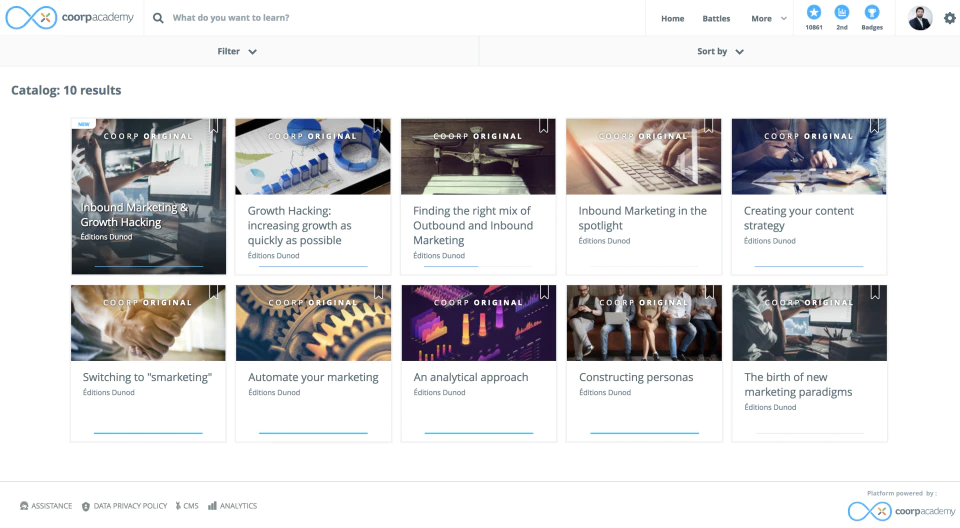
Coorpacademy. Source
Coorpacademy has all the main functions a Learning Experience Platform needs:
| Personalized learning path and content recommendations | ✅ |
| In-built Artificial Intelligence | ❌ |
| Microlearning | ✅ |
| Gamification | ✅ |
| Social learning | ✅ |
| Simple content creation and management (SCORM, xAPI, CMI5, AICC) | ✅ |
| Automated knowledge assessments | ✅ |
| Real-time analytics and reporting | ✅ |
| Rich integration capabilities | ✅ |
| Mobile design | ✅ |
This system has one of the best data visualization systems in the LXP field. It also features a unique game-based learning system allowing users to challenge one another.
✅“Interactive and innovative learning tool. Easy to use and re-start after break. Keeps you motivated to raise your learning level,” Bittu V., a Head of Business Analytics in Food and Beverages Industry, the company up to 10,000 employees
❌”Gamification has cons. The points and how they are earned. A more precise indicator is necessary to make sure the rankings are coherent to the information learned,” Andrew C., a Trade Market Coordinator in the company with 10,000+ employees.
- Capterra Rating: 4.7 out of 5
- G2 Rating: NA
- SoftwareReviews Rating: 6.9 out of 10
Degreed LXP
Degreed was launched in the US, California, back in 2012. Up to date, it has won over 25 industry awards.
Degreed is an upskilling platform with SaaS pricing plans and no free trial. The official website discloses its subscription costs upon request, though let’s rely on Venturebeat data. For enterprises, Degree offers annual contracts aligned to an organization's size, ranging from $10 to $12 per user, which equals at least $120,000 yearly per 1000 users [2022].
Degreed also targets individual users. To receive certification in a specific skill, individuals pay $129 or $399 for an unlimited membership.
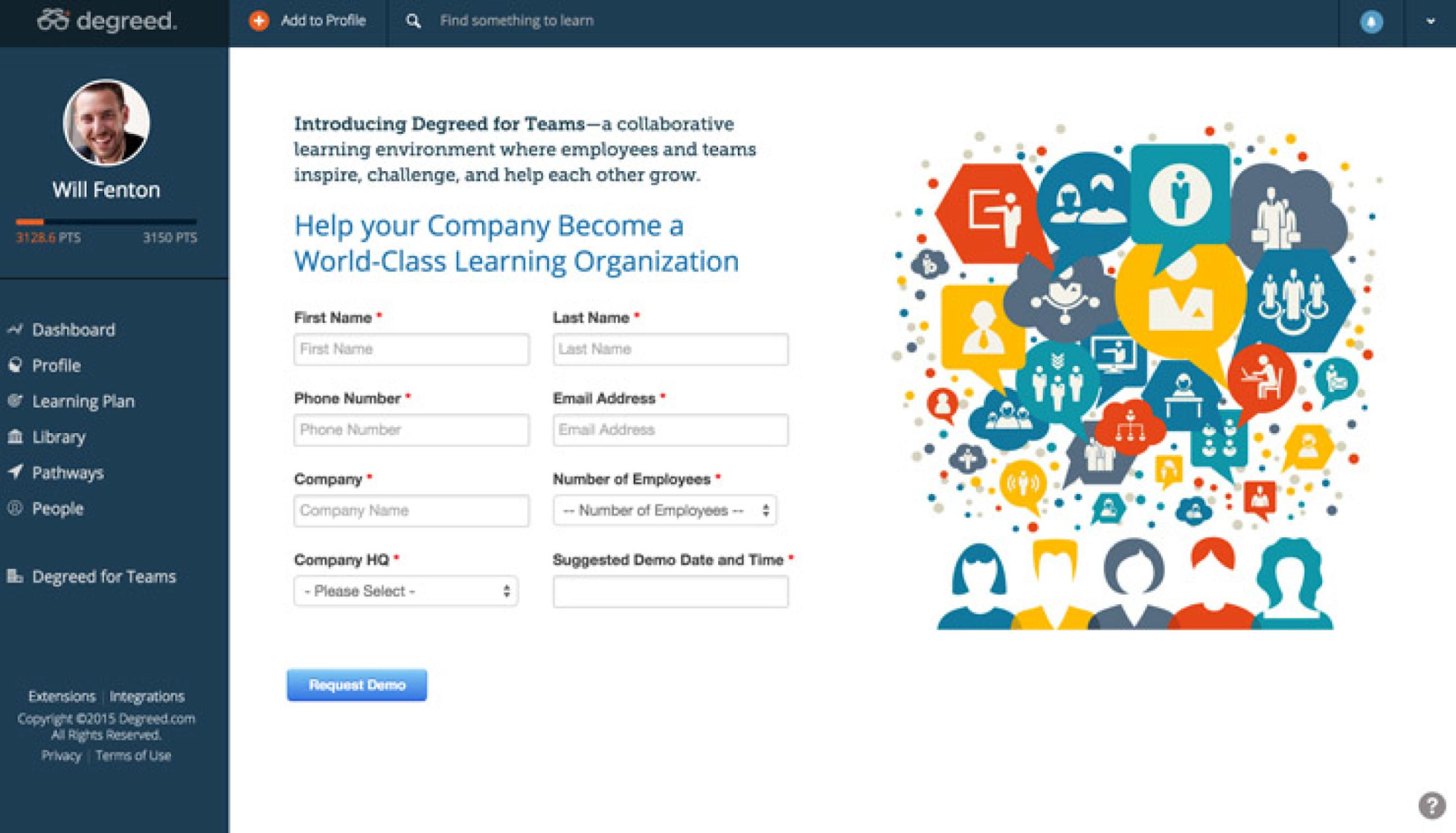
Degreed Learning Experience Platform has the following core functions:
| Personalized learning path and content recommendations | ✅ |
| In-built Artificial Intelligence | ❌ |
| Microlearning | ✅ |
| Gamification | ✅ |
| Social learning | ✅ |
| Simple content creation and management (SCORM, xAPI, CMI5, AICC) | ✅ |
| Automated knowledge assessments | ✅ |
| Real-time analytics and reporting | ✅ |
| Rich integration capabilities | ✅ |
| Mobile design | ✅ |
All-in-all, Degreed has a wide array of powerful features. However, some of them require extra fees, others still have to be improved, as some users believe.
✅“Content aggregation very strong. Ability to create learning paths from both external and internal content and assign to users/groups. Ease of creating and following learning groups. Easy to tag and create daily learning feeds. So easy to share and add content from any web source to existing internally create learning paths.,” Aaron B., People Vevelopment Representative in Organization with up to 10,000 employees.
❌”The lack of a fully developed native app and the reporting are lacking. I would like the same experience on my mobile device as I have on my laptop. Would love greater analytics e.g. to see how my team are progressing,” Todd S., a VP of Leadership & Organization Development in Real Estate.
- Capterra Rating: 4.4 out of 5
- G2 Rating: 4.3 out of 5
- SoftwareReviews Rating: 7.4 out of 10
Percipio LXP
Percipio Learning Experience Platform is developed by Skillsoft - a company specializing in eLearning since 1998 and well-known for its Skillport LMS development.
The Percipio App offers over 80,000 tools in 29 languages. Also, it is the broadest and deepest library of courses, books, and videos. The LXP offers a free trial for users. The official Percipio website has no available data about the LXP pricing, however, there is data in the 3rd-party source that a basic content collection can cost as low as $5/user for 1000 users, while for enterprise collections it can go up to $90/user for 1000 users, translating into $90,000 yearly for an enterprise.
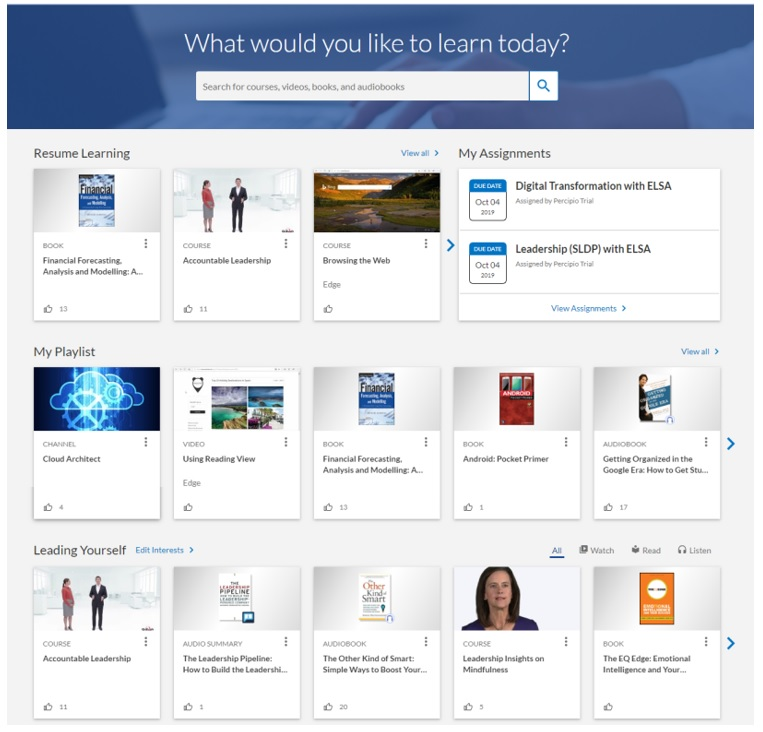
Percipio. Source
The features of Percipio include:
| Personalized learning path and content recommendations | ✅ |
| In-built Artificial Intelligence | ❌ |
| Microlearning | ✅ |
| Gamification | ✅ |
| Social learning | ❌ |
| Simple content creation and management (SCORM, xAPI, CMI5, AICC) | ✅ |
| Automated knowledge assessments | ✅ |
| Real-time analytics and reporting | ✅ |
| Rich integration capabilities | ✅ |
| Mobile design | ✅ |
Moreover, this Learning Experience Platform has a Google Chrome extension that allows you to search for content on the platform just by highlighting certain words or phrases as you surf the web. Still, the system isn’t perfect—for example, it suggests a lot of low-quality and outdated content.
✅“The Percipio interface is easy to use for both searching for courses as well as uploading new courseware. I also like the ability to house both our own company-developed content as well as content we curate from the SkillSoft library (or elsewhere) in one place,” Deborah S, HR Manager in L&D, Information Services Company with 10,000+ employees
❌“Issue with 3rd party content – right now if you have 3rd party content yourself and want to take it in Percipio, you must connect via a link. Removing outdated content and/or updating isn’t really there. I saw a lot of bad and outdated content,” Craig Weiss, a CEO and Lead Analyst for The Craig Weiss Group.
- Capterra Rating: 4.4 out of 5
- G2 Rating: 4.1 out of 5
- SoftwareReviews Rating: 7.8 out of 10
Learn Amp LXP
Learn Amp is a UK-based company founded in 2017.
Learn Amp is a combination of LXP and LMS for business.
Its pricing info is closed on Learn Amp website, but can be discovered in other eLearning sources. The subscription cost starts at $4 per user monthly, which equals $48,000 for 1000 users for 1 year [2022]. Minimal license is sold for 100 users, billed annually, and there is a free trial.
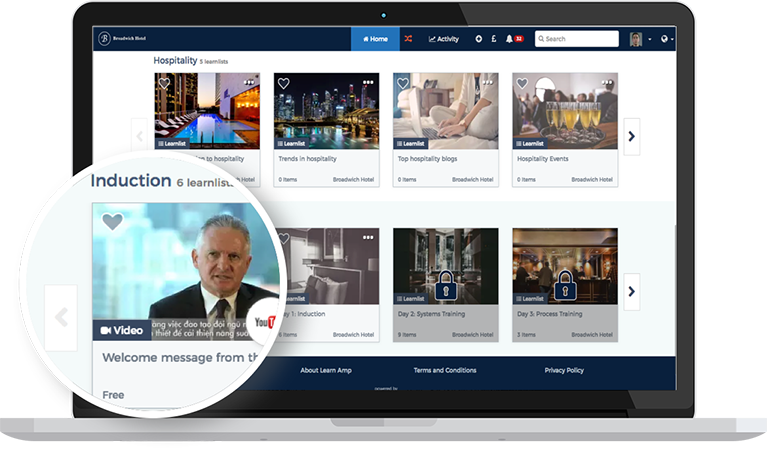
Learn Amp. Source
Learn Amp has every essential feature that you might need:
| Personalized learning path and content recommendations | ✅ |
| In-built Artificial Intelligence | ✅ |
| Microlearning | ✅ |
| Gamification | ✅ |
| Social learning | ✅ |
| Simple content creation and management (SCORM, xAPI, CMI5, AICC) | ✅ |
| Automated knowledge assessments | ✅ |
| Real-time analytics and reporting | ✅ |
| Rich integration capabilities | ✅ |
| Mobile design | ✅ |
Learn Amp is a well-balanced system with an amazing set of features. However, it seems to have gaps in content management, reporting and analytics, and might be difficult to start working with, according to some users.
✅“Having access to a large curated library allowed learners to find what they need, when they need it. There are some great social features such as the ability to rate and comment on content as well as the ability to share content with others,” Stephen P., a CEO at a Market Research Company with up to 200 employees.
❌”It would be helpful if the platform recognised Powerpoint as a file upload [...] Lacks some basics such as browser detection and SCORM logs/reports, and admin UI is clunky, especially when reviewing new/pending content, lack of search filters/tags is a pain,” Amanda R., a Head of L&D in the Entertainment company with up to 200 employees.
- Capterra Rating: 4.9 out of 5
- G2 Rating: 4.8 out of 5
- SoftwareReviews Rating: 9.4 out of 10
Thrive LXP
Thrive is a UK-based company that launched its LXP in 2019. Thrive is the LXP that, according to the company statement, can seamlessly replace a traditional LMS.
They don't have a free version or a free trial. To use the platform, there are SaaS-based subscription plans. Users need to subscribe for at least 3 years. The subscription cost depends on the number of users, for example, for 500-1000 users you'll pay $36,500 annually [2022].
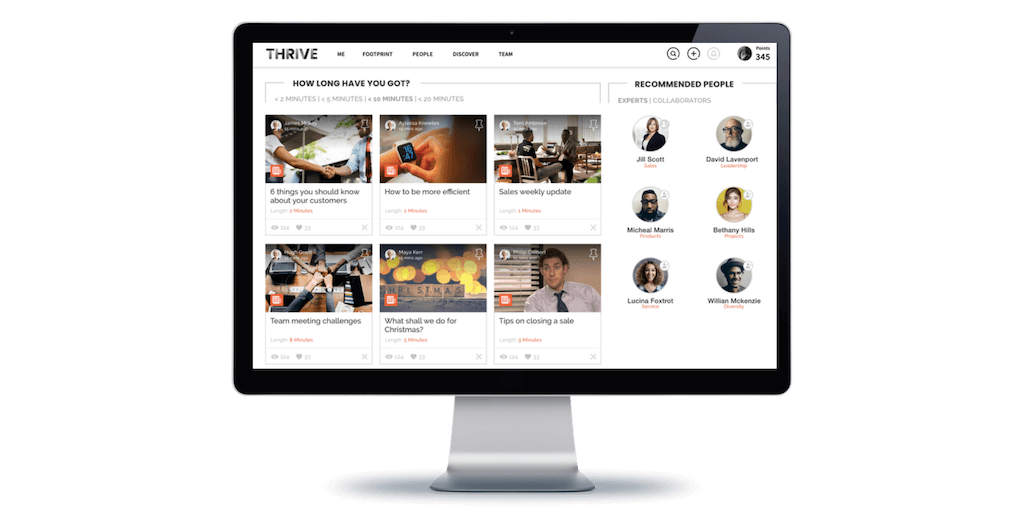
Thrive Source
Thrive Learning Experience Platform has the following core features:
| Personalized learning path and content recommendations | ✅ |
| In-built Artificial Intelligence | ✅ |
| Microlearning | ✅ |
| Gamification | ✅ |
| Social learning | ✅ |
| Simple content creation and management (SCORM, xAPI, CMI5, AICC) | ✅ |
| Automated knowledge assessments | ✅ |
| Real-time analytics and reporting | ✅ |
| Rich integration capabilities | ✅ |
| Mobile design | ✅ |
True to the LXP concept, Thrive has a great UI and UX and a powerful set of additional features such as video conferencing. However, the gaps in content management set it back, some users say.
✅“The whole user experience is fantastic—it's easy, it's reminiscent of our favourite social media channels, it's simple and super intuitive—No instruction guides required!”, Angela T., a Director of L&D at Real Estate Company with up to 500 employees.
❌“The only negative I think is the versioning of content being uploaded, so you can't version a new SCORM package. We couldn't edit the content to our brand,” Andy H., a Digital Learning Specialist, Financial Services with up to 500 employees.
- Capterra Rating: 4.7 out of 5
- G2 Rating: 4.7 out of 5
- SoftwareReviews Rating: 8.7 out of 10
Infuse LXP
Infuse Learning Experience Platform was developed by Absorb in 2019, following the famous Absorb LMS.
The platform has a free trial and SaaS pricing depending on the features. Hosted pricing from Absorb starts at $1,350 per month for 500 users, which results in $29,000 per year for up to 1000 users [2022]. However, this pricing has been lately applied rather to Absorb LMS with LXP cost available upon request only.
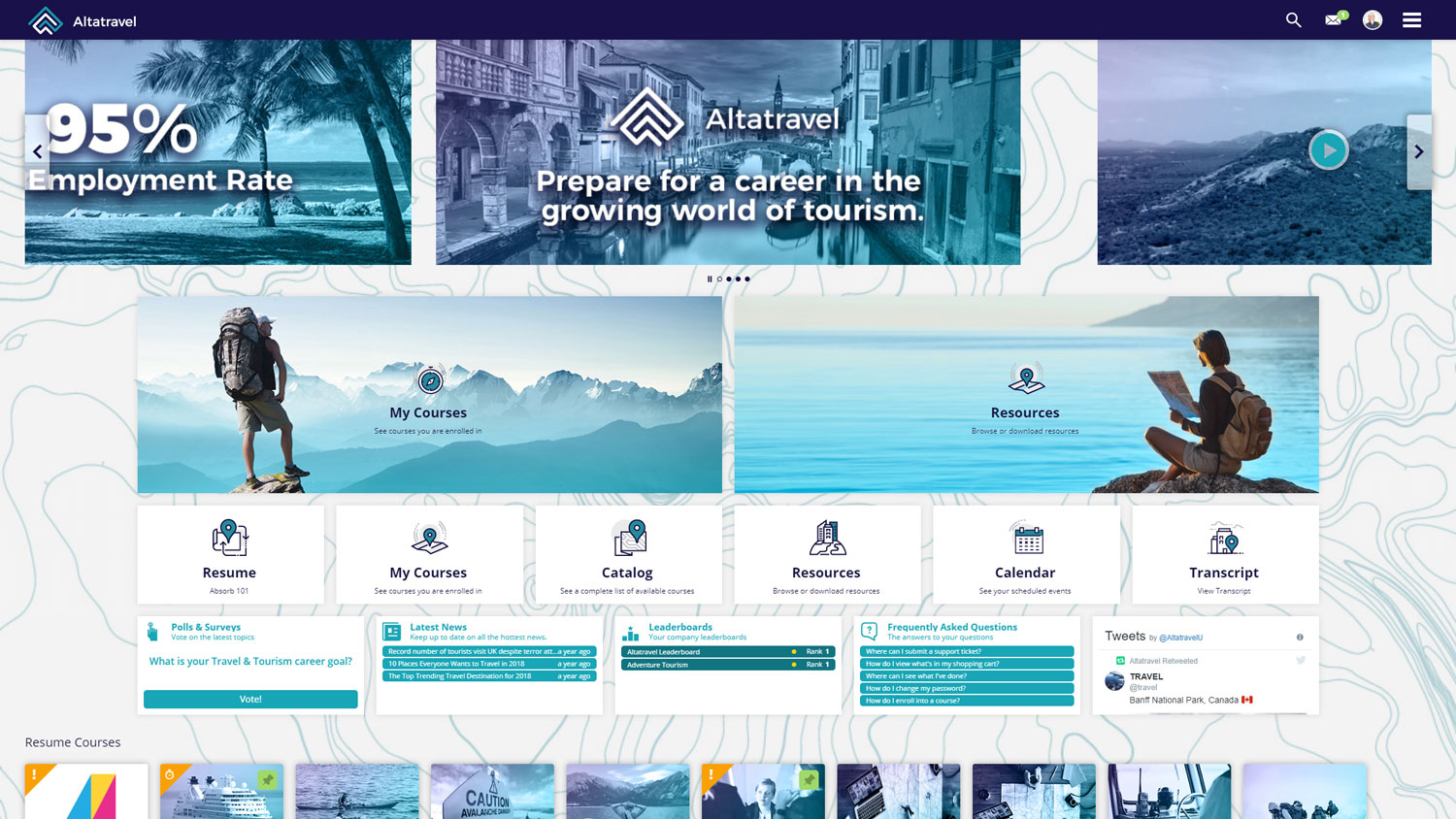
Absorb Infuse. Source
Infuse comprises the following major functions:
| Personalized learning path and content recommendations | ✅ |
| In-built Artificial Intelligence | ❌ |
| Microlearning | ✅ |
| Gamification | ✅ |
| Social learning | ✅ |
| Simple content creation and management (SCORM, xAPI, CMI5, AICC) | ✅ |
| Automated knowledge assessments | ✅ |
| Real-time analytics and reporting | ✅ |
| Rich integration capabilities | ✅ |
| Mobile design | ✅ |
Infuse’s UI is good, although inconsistent in some places. It also has certain in-built gamification elements and its skills/certification management is solid as well. However, it could have easier content management and support, as some users claim.
✅“Admin side is intuitive and offers easy templates for a variety of customizations, while the user side offers multiple layouts that they can control and different options to check in on their training progress and certificates. It's so easy now to push out training and reminder messages to mass groups or individuals,” Pamela B, HR at Healthcare Organization with up to 1000 employees.
❌“No versioning, so when you update a course, you have to re-enroll all users. Enrollment delays with our new learners are also frustrating for the learners and our teams. The delayed support response times when submitting a ticket have been very long, resulting in extended down times. Not being able to call the support team direct for a quick inquiry or assistance is very frustrating,” Sunny B., a Marketing and Advertising Manager in a company with up to 1,000 employees.
- Capterra Rating: 4.4 out of 5
- G2 Rating: NA
- SoftwareReviews Rating: NA
Edcast LXP
Edcast is a US-based eLearning company that has been founded in 2013.
EdCast LXP is a SaaS solution. Its subscription data is available upon request only. According to AWS sources, the EdCast enterprise plan costs $2 per user monthly, which translates into $24,000 yearly for 1000 users. Note that the enterprise plan supposedly has the minimal threshold of 2000 user licenses [2022]. No free trial is available.
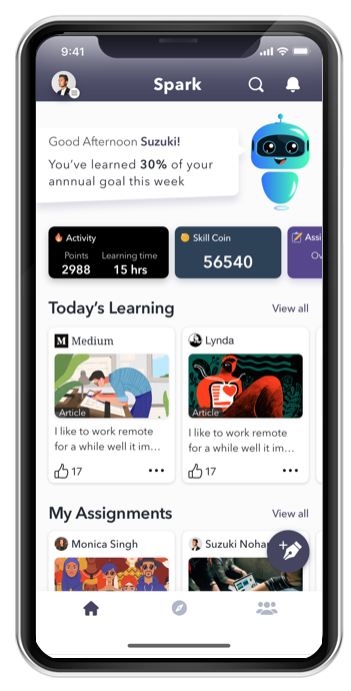
Edcast on a mobile device. Source
Edcast Learning Experience Platform features include:
| Personalized learning path and content recommendations | ✅ |
| In-built Artificial Intelligence | ✅ |
| Microlearning | ✅ |
| Gamification | ✅ |
| Social learning | ✅ |
| Simple content creation and management (SCORM, xAPI, CMI5, AICC) | ✅ |
| Automated knowledge assessments | ✅ |
| Real-time analytics and reporting | ✅ |
| Rich integration capabilities | ✅ |
| Mobile design | ✅ |
In addition, the company has a marketplace where the users can buy quality learning content and connect from experienced corporate trainers.
Edcast is liked for its rich functionality and powerful AI for talent management. However, the administration side as well as mobile UX still has to be improved, some users say.
✅“Features like progress tracker, pathway, timely notifications, AI enabled suggestions among others helped in staying engaged with the course in the long run. All this put together with the powerful integrations from various platforms have made Edcast an Ideal LXP platform which is sure to lead the way in this industry,” Vira S., a Digital Marketer in Software Development Company with up to 50 employees.
❌“The Android app sometimes fails to log in, it requires some bug fixing [...] there are many blank and empty pages and buttons which don't lead to any content.” Abhay J., a Senior Manager in the Enterprise with over 1000 employees.
- Capterra Rating: 5 out of 5
- G2 Rating: 4.6 out of 5
- SoftwareReviews Rating: 8.5 out of 10
Valamis LXP
This Finnish company has been on the market since 2003, although its LXP offering is much younger, its development started in 2010.
Valamis LXP is available like a SaaS or perpetual license. Best for large enterprises for £15,000 per instance, according to the UK governmental source (official info upon individual request). Paying for instance means that a company gets a copy of the product and can use it for all their employees, whether it be 100 or 1000 users. A free trial is offered.
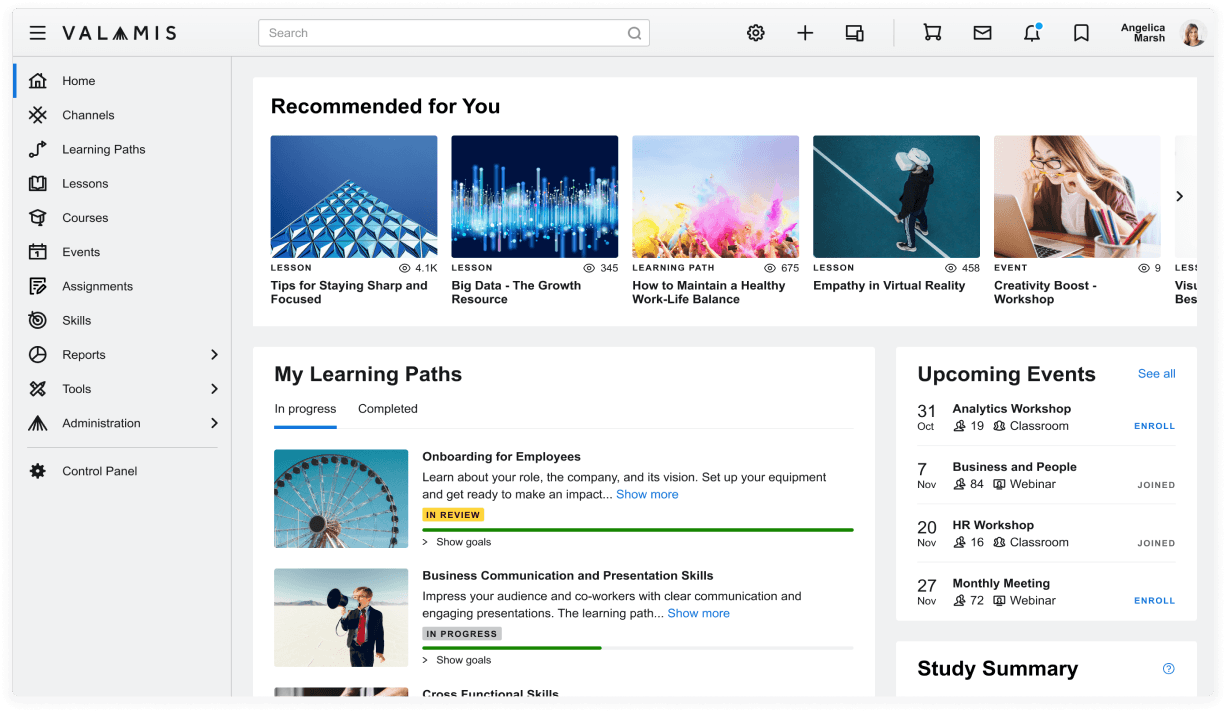
Valamis. Source
Valamis has all the core features of a Learning Experience Platform and a bit more:
| Personalized learning path and content recommendations | ✅ |
| In-built Artificial Intelligence | ✅ |
| Microlearning | ✅ |
| Gamification | ✅ |
| Social learning | ✅ |
| Simple content creation and management (SCORM, xAPI, CMI5, AICC) | ✅ |
| Automated knowledge assessments | ✅ |
| Real-time analytics and reporting | ✅ |
| Rich integration capabilities | ✅ |
| Mobile design | ✅ |
As the platform has only been on the market for a short time, there are still few comments. Customers praise Valamis for its flexibility and scalability, although they consider it to be quite pricey and lacking some functionality.
✅“One of the best learning platforms and best IT-project what I have lead as a customer. Softwares best parts are xApi interface and it's scaleability for different usecases and ammount of users,” Ville T., Manager at Educational Organization with up to 1000 employees.
❌“Pricey. No built-in shopping cart. Course Library managed by the third party,”Akshata Fernando, a Digital Marketing Professional
- Capterra Rating: 4.5 out of 5
- G2 Rating: NA
- SoftwareReviews Rating: NA
Instilled LXP
The Instilled LXP has been released in 2019. After its launch, this system was named as a Top 20 Learning Experience Platform by Training Industry 2 years in a row.
Instilled LXP has a free trial and SaaS pricing depending on the number of users. The pricing information is closed and should be requested individually.
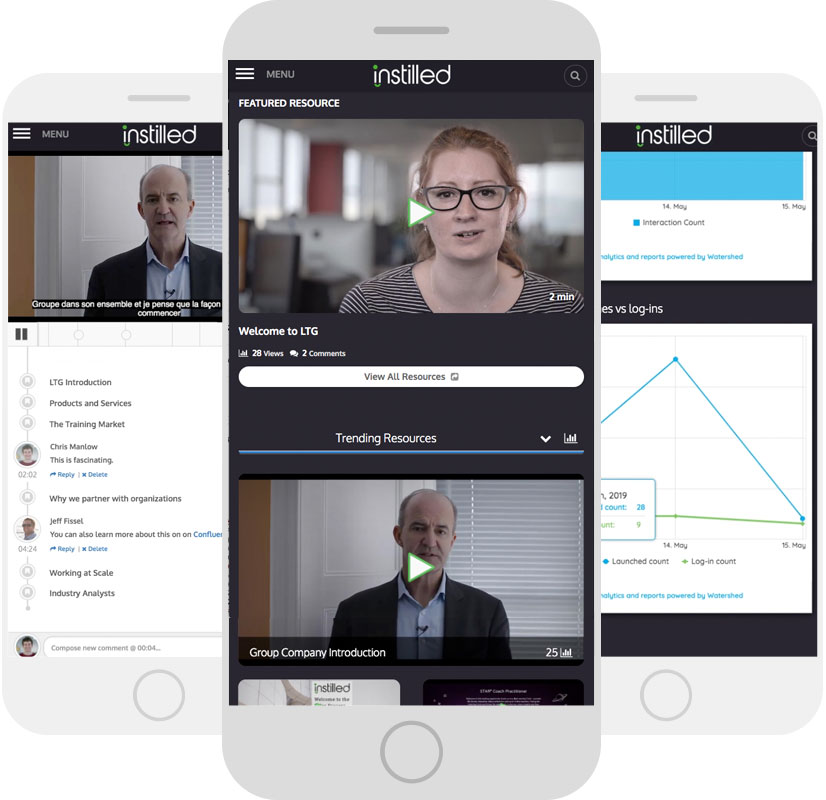
Instilled. Source
These functions are at the core of Instilled LXP:
| Personalized learning path and content recommendations | ✅ |
| In-built Artificial Intelligence | ❌ |
| Microlearning | ✅ |
| Gamification | ✅ |
| Social learning | ✅ |
| Simple content creation and management (SCORM, xAPI, CMI5, AICC) | ✅ |
| Automated knowledge assessments | ✅ |
| Real-time analytics and reporting | ✅ |
| Rich integration capabilities | ✅ |
| Mobile design | ✅ |
Instilled is praised for its powerful authoring tools (especially video editing), robust analytics, major eLearning standards integration, and seamless UI and UX. Unfortunately, the lackluster data visualization and lack of content partners are its bottlenecks.
✅“Very good video editing tool. UI is crisp, UX is solid. Ability to subscribe to your favorite videos and/or playlists. Can upload your own content – many LXPs do not offer this, I know shocking. Anyway, accepts SCORM too. Solid Admin UX,” Craig Weiss, a CEO and lead analyst for The Craig Weiss Group
❌“Data visualization is there but needs more options, better visualization … what is there, works, but if there was just a touch more of ability to only have video as content. No content partners upon launch,” Craig Weiss, a CEO and lead analyst for The Craig Weiss Group
- Capterra Rating: NA
- G2 Rating: NA
- SoftwareReviews Rating: NA
Custom LXP vs Ready-Made LXP
Top LXPs on the market are great examples of intuitive and engaging learning platforms with great functionality. However, the peculiarity of any ready-made solutions is that they target a wide range of use cases instead of focusing on what your company or industry needs. So your employees, clients, or students might need to adapt to a platform. Belitsoft’s eLearning team has researched the common issues of top 10 LXPs on the market, so that you could see how critical they might be for your case and what you can do to avoid similar issues.
Below you'll find about 40 verified customer reviews from the most trusted services such as trustraduis.com, capterra.com, elearningindustry.com, and g2.com. They reveal what top Learning Experience Platforms on the market may lack from customers' viewpoint.
The research is aimed to help you see common bottlenecks in ready-to-use platforms and make an informed decision whether these issues are non-critical for your business or you'd better opt for a custom solution.
The reviewed LXPs are Degreed, Edcast, Learn Amp, LinkedIn Learning, Percipio, Thrive, Coorpacademy, Valamis, Absorb Infuse, and Instilled.
Top 6 Disadvantages of the Best Ready-Made LXPs & Ways to Resolve Them
1. Security issues
Security is the core priority for enterprises. Secure software keeps all your employees' data and learning materials safe and private. Some ready-made solutions may create the risk of your data going public due to some internal technical issues. One of the reviews from the government administration reported such an issue while using Degreed.
Brian N., a Retirement Benefits Specialist, the Government Administration with up to 1000 employees:
“Occasionally the Integrations section bugs out and it requires you to make your information public. Given security, there is no easy answer to that but wish there was a way to interconnect but keep others sites private.”
How Custom LXP Resolves the Issue
Developing a custom LXP is your go-to solution for having full control and security. In this case, you own it and can implement any changes to boost its security level.
For example, your development team can
- ensure GDPR compliance,
- create strong backup system,
- restrict user privileges to prevent risky files downloading and sharing,
- encrypt data for safety,
- keep up with security updates,
- enable 2-factor authentication, and
- apply other security measures based on your industry and company demands.
As a result, you can control the security of your software without letting a 3rd party into your company data.
2. High subscription fees
Upskilling and reskilling employees implies their continuous learning, which in its turn, requires purchasing a subscription plan. All the top LXPs on the market have a SaaS pricing model. It means that you pay a monthly or yearly subscription fee that usually grows with every new feature or employee.
For example, Coorpacademy that is reportedly used by CEOs, entrepreneurs, HR Directors, and CDOs charges SMBs 8€ per user monthly. For enterprises, the cost is 15€ per user monthly, which translates into €180,000 for 1000 user licenses per year [2022]. In LinkedIn Learning, an annual subscription equals $19.99 per month [2022]. As a result, the expenses for educating 1000 employees reach the staggering $240,000 per year.
Andreea C., a B2B strategist in a company with up to 1000 employees, notes that the price of LinkedIn Learning LXP is quite high:
“As all with regards to Linkedin, the prices are very high. They are VIP prices that would best go down.”
Avani J., a Marketing analyst in a small company with up to 50 employees, agrees that: “LinkedIn Learning is an expensive platform - there are alternative applications that let you subscribe to particular courses that you want to opt for - saving you the hefty price of paying for the entire library.”
How Custom LXP Resolves the Issue
To save in a long term due to avoiding subscription fees, companies, especially enterprises with 1000+ employees, sooner or later come to the idea of developing their custom learning platform. With a custom system, you don’t pay subscription or license fees.
In addition, when your initial investment pays off, a custom LXP will become a highly demanded product that you can resell.
The high demand on LXPs confirms the global analyst Josh Bersin that refers to LXP as “the learning delivery platform of the future”. He states that investments in LXPs are growing exponentially. By 2026, the LXP market is supposed to reach almost $2,2 Billion.
3. Gaps in content management
No possibility to conveniently upload 3rd-party content
Andy H., a Digital Learning Specialist, Financial Services with up to 500 employees, wish that the LXP would love to upload new content to Thrive LXP easily:
“The only negative I think is the versioning of content being uploaded, so you can’t version a new SCORM package.”
Craig Weiss, a CEO and Lead Analyst for The Craig Weiss Group, met with the problem of content updating in Percipio LXP:
“Issue with 3rd party content – right now if you have 3rd party content yourself and want to take it in Percipio, you must connect via a link. Culling i.e. removing outdated content and/or updating isn’t really there. I saw a lot of bad and outdated content.”
No downloading and offline learning option
Carmen Rodriguez, an Enterprise Retail Sales Manager, the Bank of America with 1000+ employees, the user of Degreed LXP:
“Degreed does not allow me to download articles or learn topics shared by my co-workers. This would be an incredible feature since you could have the learning outside the platform, without the need to be connected to it.”
Richard (Ric) Hazel, a Senior Project/Process Analyst, FedEx Customer Technologies, 10,001+ employees, the user of Percipio LXP:
“The biggest issue I have is that you have to be online to read the books. It would be nice if there was a download option where you could read the book in an e-reader app like Kindle or Nook. Having an option to highlight sections of the book as you are reading it would be very helpful.”
Few content formats are supported
Kristin, a Sales Operations Analyst, a company with up 1000 employees, the user of Percipio LXP:
“Sometimes, there's only access to audiobook versions. At least let me access a transcript.”
Amanda R., a Head of L&D, the entertainment company with up to 200 employees, the user of Learn Amp LXP:
“Doesn't recognise Powerpoint...”
Darcy M., a Director at L&D, the Construction Company with up to 1000 employees, also names some issues while using Thrive LXP:
“Currently not able to add images to quizzes or use quizzes as real-time edited knowledge checks or surveys. Not able to add images to articles, questions, or comments.”
Craig Weiss, a CEO and lead analyst for The Craig Weiss Group, would prefer to have more useful content in Instilled LXP:
“Data visualization is there but needs more options, better visualization … what is there, works, but if there was just a touch more of ability to only have video as content. Yes, you can have the match of a PDF, PPT, etc. to the video, but in the playlist, it is video content only… ”
How Custom LXP Resolves the Issue
Building a proprietary LXP can resolve all the abovementioned issues that impede your employers to learn and grow. The software development team can ensure the following content management functionality in your LXP:
- Easy uploading of a 3-rd party content due to SCORM, xAPI compatibility;
- Content downloading and offline learning thanks to the offline mode support;
- Support of multiple content formats including video, audio, text, pictures, etc. to stimulate users’ retention and better outcomes.
4. Lacking admin functionality
When an admin doesn’t have full visibility of the system or lacks functionality, it might lead to poor learning outcomes overall.
Among the major drawbacks of ready-to-use platforms for admins, usually L&D officers, there are the absence of customization for industry needs, scarce reporting that impedes evaluating the ROI of learning, no leaderboards, or the limited possibility to manage content.
Sasha Brito, a Marketing Director at GAL, Real Estate Enterprise with up to 5000 employees, finds employees’ progress monitoring through Degreed LXP rather troublesome:
“One of the main challenges that have arisen during the use of Degreed is that I must constantly review the learning behavior of each of my employees. Degreed does not have a notification system that alerts me when an employee is active on the platform and is learning, this platform does not offer me that notification system. It is a bit annoying having to watch out that our employees are fulfilling their duties in the apprenticeship that has been placed on them.”
Suraj M., an LMS Specialist, the Enterprise with 1000+ employees, confirms that admin functionality in Degreed LXP could be optimized:
“As an admin, some abilities are desired. Insights dashboards on the admin fronts could have more customization options. Option to clear Notifications would be helpful. Expiring content, a simple LMS under the hood would be great.”
Rachel M, an L&D Officer, a Mid-Market company with up to 1000 employees, would prefer some customization capacity as an admin of Edcast LXP:
“I would love for them to allow us to built custom dashboards as per our industry needs.”
Jack P., a Senior Learning Consultant, Financial Services with up to 1000 employees, wishes Thrive LXP worked as he’s hoped:
“The quiz function doesn't provide us with the feedback/stats that we were hoping for. Some of the admin features are very light in comparison a traditional LMS. An example of this, is the reliance on external API links to view the data rather than having reports that can be customisable in Thrive can limit the admin experience and does require IT resource to help set this up and external software to review the data.”
Vicki B., a People Manager, the Food & Beverages services with up to 200 employees, considers the lack of some features in Thrive LXP to be weird:
“Some of the functionality can be odd - eg why can't we get live information on points, some people really want to know where they are on the leader board. Having to go through each user is laborious and I would really loathe this job with more than 150 employees! Would be great to have a 'read and understood' option in learning pathways to have evidence that users have completed their assigned training.”
Matt, a CEO, the Human Resources services with up to 10 employees, would love to get reports from Thrive LXP:
“There are some things that are missing from the nice to have list, such as detailed and easy to use reporting features.”
Frank Z., a representative of an Enterprise with 1000+ employees, feels rather dissatisfied that user management in Edcast LXP is not well-thought:
“Administrators can't proxy in as users to see their experience in the system. It does not allow Admins to complete content for users.”
Susan M., a Representative of the Automotive Company with 10,001+ employees, also notices some problems as an admin:
“As managers, we can’t measure or track the progress of our specific team. It’s hard to navigate through to know where you are in the courses.”
Hitesh M., a digital marketer at IIM Udaipur, a Mid-Market company with up to 1000 employees, suggests more interaction between admins and users within Edcast LXP:
“I have one suggestion to add more points of interactions [of admin] with the user and make it easy to access the report of these interactions to understand and improve engagement.”
Samantha H., an Office Manager, the Travel & Tourism company with up to 200 employees, the user of Learn Amp LXP:
“As mentioned from an administrator point of view, the set up does require some time and thought. More video tutorials would have been helpful so that I didn't need to call up, although I do always get a swift response.”
Savannah, a teacher, also had this issue with Learn Amp LXP:
“When we just started working together, there were specific requirements regarding the management reports, some of them required additional development.”
How Custom LXP Resolves the Issue
Building a proprietary LXP deprives you of any decisions that third parties might make, such as changes in the interface or navigation and limited admin functionality. Your software development team can add all the functionality that ready-made platforms may lack enabling:
- Transferring data among your LXP, HR, LMS, and other in-house software with the help of API integrations;
- Customization for industry and company needs;
- Setting up automated notifications for admins about users’ activities;
- Applying a leaderboard for maintaining users’ interest;
- Detailed and customizable reporting for getting timely insights about the learning progress and outcomes;
- Automating training and on-boarding process through creating a series of tutorials and manuals for users and LXP admins.
5. Buggy user experience
An engaging eLearning experience requires an LXP to be well-designed, user-friendly, and simple to use. However, there are multiple offers on the LXP market with a series of issues that make a user experience troublesome.
Poor navigation, filtering, and content search
Pamela B., a Business Analyst and Project Manager, Management Consulting Company with up to 10 employees, the user of Thrive LXP:
“Inability to section our customer content, lot of messing about tagging and setting up custom fields to ensure customer sees learning content, this should get easier soon. Sections not being able to subsection to make pathway left hand side menu be slicker and easier for the learner.”
Laura S., a Web Designer, Higher Education Enterprise with 1000+ employees, the user of LinkedIn Learning:
“The amount of content is poorly organized and is overwhelming. It would be helpful to have an option to filter and to be able to wort by difficulty or video length so that you could easily find something to fit your experience level and time constraints.”
Matt LeMaire, a Vice President, Peel Mutual Insurance, up to 50 employees, the user of LinkedIn Learning:
“If you have created a Learning Path, the editing of courses and order/placement can be problematic as rather than being able to easily shuffle courses between sections of a learning path, you would have to delete and start over. I should be able to move course x from section c to section a without issue.”
Ashley D, an Account Manager, an Enterprise with 1000+ employees, gives an extended answer on what content management functionality in Degreed LXP is lacking:
“What I dislike is how I have to go back to the course's main page to mark each item as complete. I wish it would hide my finished section and then prompt me to move on to the next section. Since I have to be redirected back to the list, I can miss items.
It also doesn't have a pop-up for when I'm 100% complete so I never know that. I also don't get an email confirmation when I complete something. That means I have to go back and check. There should also be something where I can group my classes by Completed, In progress. Unfortunately currently no way.”
Olha K, a marketing manager, Small Business with up to 50 employees, the user of Edcast LXP:
“... there are many blank and empty pages and buttons which don't lead to any content.”
Irrelevant learning materials and follow-up tasks
Kerry A, Civil Engineer, a company with 1000+ employees, had problems with the relevance of the courses in LinkedIn Learning:
“The course recommendations do not always feel relevant to my profession.”
Emmanuel B., a Governance web manager, Electrical/Electronic Manufacturing, 10,001+ employees:
“Some quizzes questions are not relevant: sometimes the answer is different to what is said in the video, sometimes the question requires an EXACT word for the answer: this is completely useless!! To succeed you need to review the video to stop and catch the exact sentence and to write it as an answer: Big loss of time for nothing.”
Jeyaseelan M., ITSO, Farming, 10,001+ employees:
“Some links are not clear that the users need to click in order to move on to the next level. Not possible to review correct answers after the testing is over - no means of reference - even to quote reference in this exercise.”
How Custom LXP Resolves the Issue
Building a custom LXP powered by Artificial Intelligence will resolve the mentioned issues. AI-based LXP gives you key functionality that favors business, such as:
- personalized learning paths,
- accurate content recommendation,
- automated skills assessment,
- workforce performance progress tracking,
- workforce performance forecasting, and many more.
6. Technical issues
Among the disadvantages of ready-made LXPs named by customers, there are also some technical issues. For example, Zoom doesn’t work normally, there is poor audio quality, timing out and logging out a user after a few minutes of standby, and some others depending on a platform.
Missree V., an Assistant Manager - Offer Marketing, Electrical/Electronic Manufacturing, 10,001+ employees, the user of Coorpacademy LXP:
“Sometimes, the interface is super slow and it is irrespective of the network connection.”
Josh H., Co-Founder & CEO of a small business with up to 50 employees, reports rather poor audio quality in LinkedIn Learning:
“The audio quality for the videos goes in and out when I'm listening while driving. It gets pretty poor quality oftentimes.”
Rick, Tech Writer in the Hospital & Health Care company with over 1000 employees, didn’t manage to import certificates into his personal account from LinkedIn Learning:
“There is an issue with the certificate import from one account to another. Sometimes, due to the availability of a premium account through organizational mail, people tend to complete the expensive courses using it and avail certificate but cannot add it to their personal account without any hassle. This issue is irritating. There should be a way to validate the authenticity of the user and then help them import the certificate.”
Abhay J, Senior Manager, the Enterprise with over 1000 employees, the user of Edcast LXP:
“The android app sometimes fails to log in, it requires some bug fixing.”
Kristie, a Designer, found that Zoom meeting in LinkedIn Learning might work not properly:
“Several times, I have used LinkedIn to learn about a specific job like Product Management and when I tried to use the Zoom meeting, I never got let into the meeting. It might be a technical issue but I have missed out on a lot of meetings on LinkedIn because the Zoom meetings were not coordinated properly.”
Steven, a Senior Business Development, an Enterprise with 1000+ employees admits having issues when working with Percipio LXP:
“It times out if you leave the window open without advancing. Sometimes I will have to start over and log back in if I don't take any actions for a few minutes.”
Janelle M., an L&D Manager/Instructional Designer at Ten Group with up to 1000 employees, found Learn Amp LXP difficult to set up:
“While launching, we had some problems with some of our learners not being able to log in and use the system.”
Felipe R, School Advisory Council, up to 50 employees, also had some bugs while using Edcast LXP:
“[I’d like] the correction of some bugs such as the pages do not load automatically, being necessary to make an update with some frequency.”
How Custom LXP Resolves the Issue
When you build a custom LXP, you partner with a software development company that will take responsibility of building the software with clean, usable code. The developers will apply software testing and Quality Assurance best practices to deliver a robust platform with efficient and thorough code that prevent any of the abovementioned bugs.
Three strong reasons to opt for a custom LXP:
1. Full control and security
Developing a custom LXP, you own it, and you are free to decide what functionality, design, and branding it will have. You can tailor the LXP to your company, industry, employees, and learning goals. Also, you ensure the security level you want and can control this aspect without letting a 3rd-party into your personal space.
2. Saving in the long run due to avoiding subscription fees.
All the top LXPs on the market have a SaaS pricing model. It means that you pay a monthly or yearly subscription fee that usually grows with every new feature or employee. With a custom system, you don't pay subscription or license fees. When your initial investment pays off, a custom LXP will become an asset.
3. Adding new functionality like AI or API integrations.
By implementing Artificial Intelligence into your LXP, you get key tools that favor business, such as personalized learning paths, accurate content recommendation, automated skills assessment, workforce performance forecasting, and many more. As for API integrations, they allow you to transfer data among your LXP, HR, LMS, and other software that you currently have in use.
4. Getting your own LXP as a product and reselling it.
The LXP is “the learning delivery platform of the future”, claims the global analyst Josh Bersin. And investments in LXPs are growing exponentially. By 2026, the LXP market is supposed to reach almost $2,2 Billion.
How Belitsoft Can Help
- Custom LXP development. This is your option in case ready-made LXPs don't fit your needs, our eLearning team will build you a custom LXP from scratch, like we already did for the US training company.
- LXP customization. Opt for this option if you're using an open-source system ready-made or custom LXP already, but want to change a logo and a color scheme or add new features and modules.
- LXP consulting. If you need an expert opinion, address to our team, led by a CTO who is an eLearning Forbes Council with 17+ years of expertise. We'll examine your needs in depth and recommend the best solution for your individual case.
Help your employees demonstrate higher levels of productivity by upskilling and reskilling them in an engaging manner. Attract more clients and students by delivering easily digestible and relevant content. Use an LXP that will directly impact your business success. Our eLearning experts welcome you to discuss your ideas.
Rate this article
Recommended posts
Portfolio

Our Clients' Feedback






















.jpg)
.jpg)
.jpg)
.jpg)














We have been working for over 10 years and they have become our long-term technology partner. Any software development, programming, or design needs we have had, Belitsoft company has always been able to handle this for us.
Founder from ZensAI (Microsoft)/ formerly Elearningforce